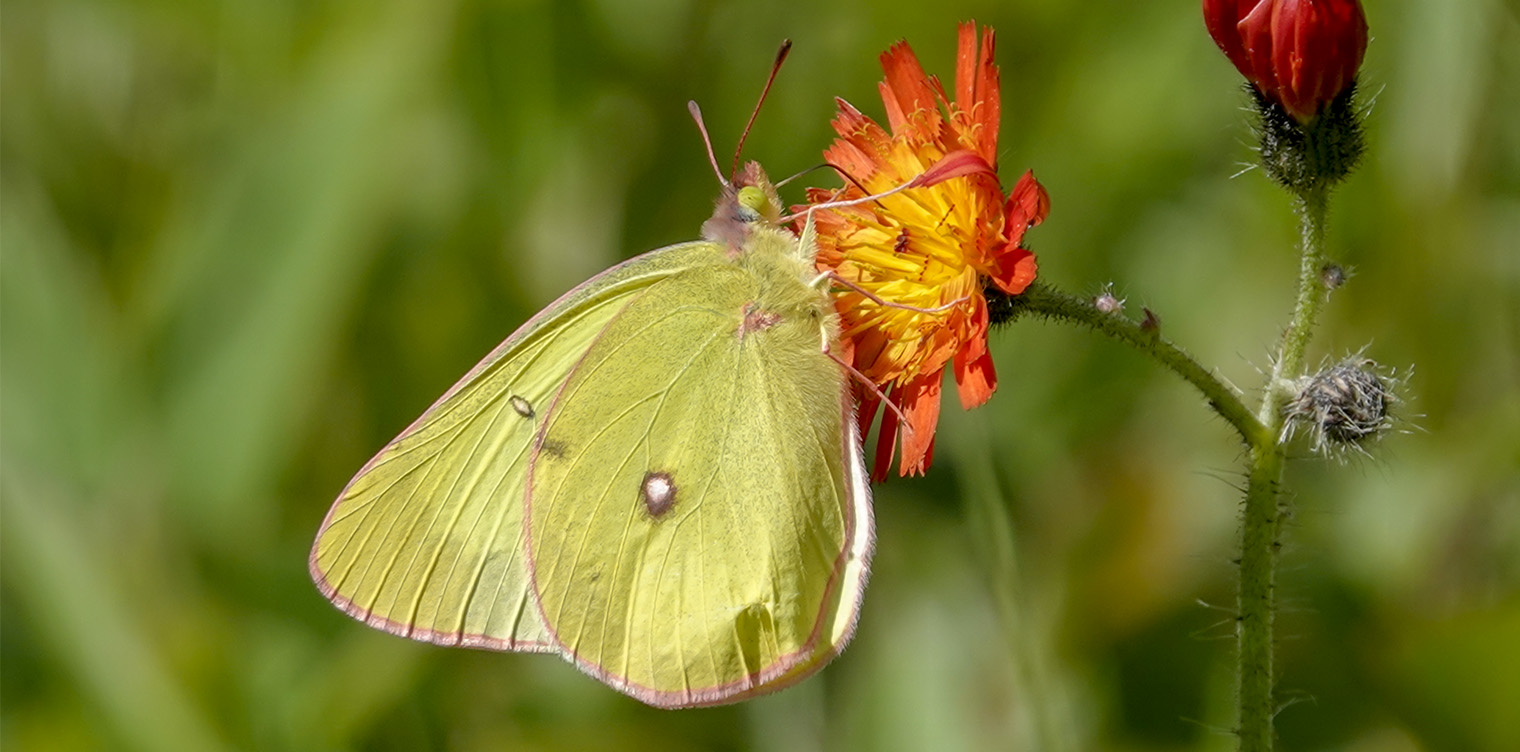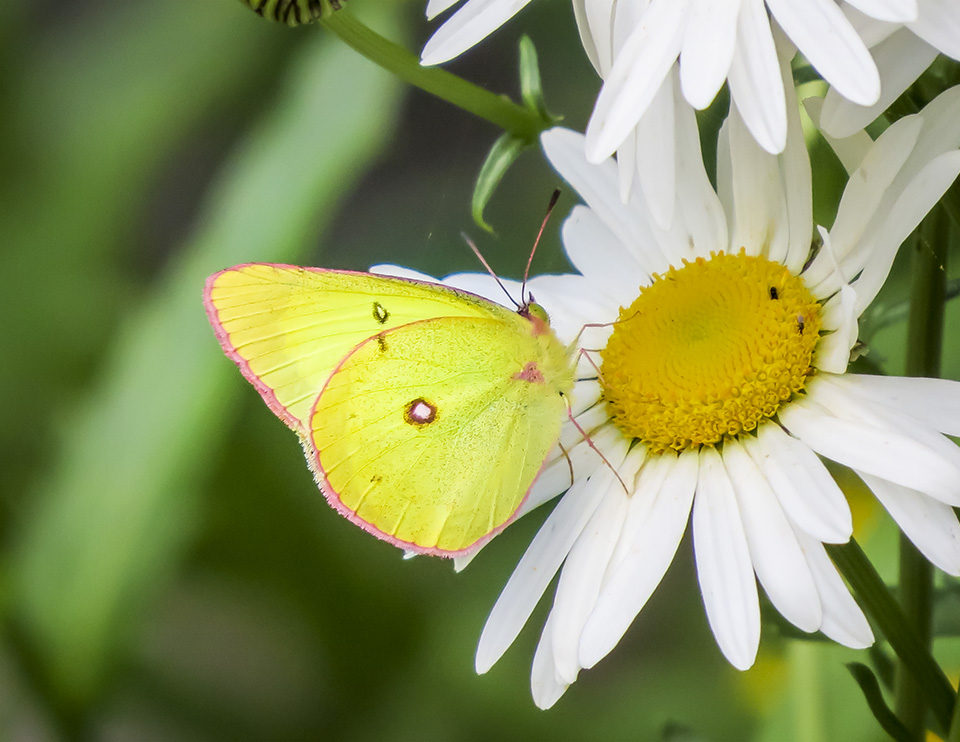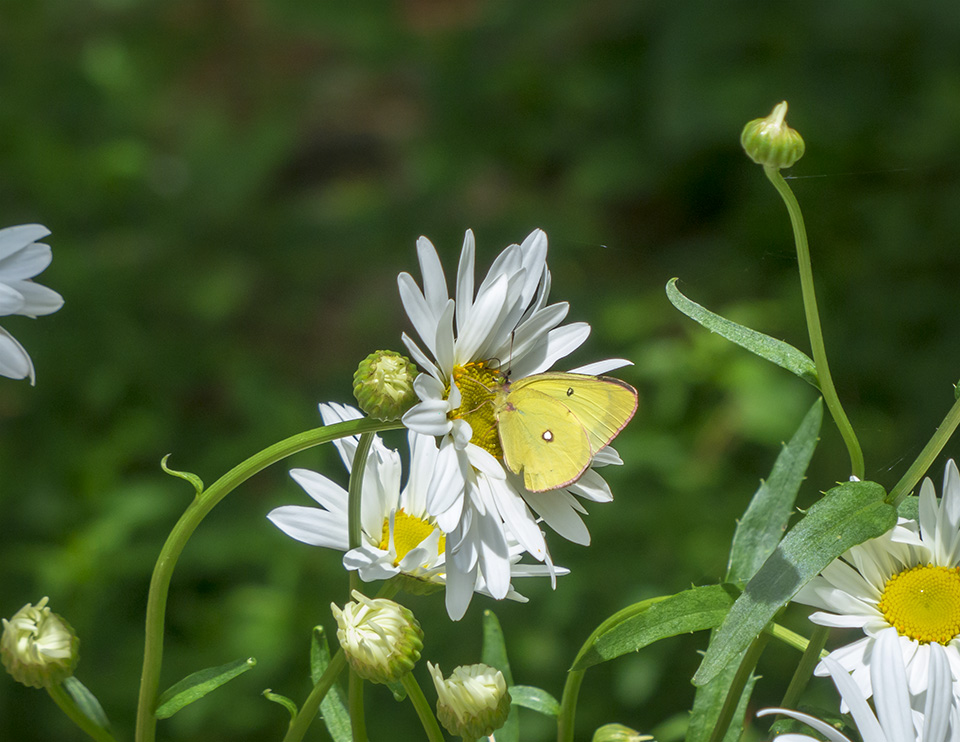Butterflies of the Adirondacks:
Pink-edged Sulphur (Colias interior)

The Pink-edged Sulphur (Colias interior) is a medium-sized yellow butterfly that may be seen in the Adirondack Mountains of upstate New York in June and July. It is a member of the Pieridae family. [1] [2]
The Pink-edged Sulphur is one of three members of the Colias genus found in the Adirondack Park. The others are the Clouded Sulphur and the Orange Sulphur. Butterflies in this genus are usually some shade of yellow, orange, or white. [3] Seen from above, they have black borders, solid in males and with pale spots in females. All of our sulphurs usually perch with closed wings, which complicates identification.
Pink-edged Sulphur: Identification

The main color to look for in identifying the Pink-edged Sulphur is a light to bright yellow. [4] The wings are rounded. Both males and females have conspicuous pink wing edges. [5] [6] The upper side is bright yellow with a black border. [7] [8] However, this butterfly normally rests with its wings closed, so the upper side is rarely seen. The underside of the hind wing is a clear yellow with a single silver cell spot circled in pink. [9] [10] It has no post-median spots. [11] The wing span 1½ to 2⅝ inches.
The Pink-edged Sulphur is easily confused with the very similar Clouded Sulphur and the Orange Sulphur, both of which are also seen in our part of the Adirondacks.
- The Clouded Sulphur normally has dark spots on the underside of the hind wing. [12] [13] In addition, the center spot on the underside of the hind wing is usually double. [14]
- The Orange Sulphur also has a series of dark spots on the underside of both wings. However, there is normally an orange patch on the fore wing, which distinguishes it from the Clouded Sulphur.
- The Pink-edged Sulphur has conspicuous pink wing edges and lacks the dark spots on the underside of the wings.[15] [16] The center spot on the hind wing is single, rather than double. [17] [18] [19] [20]
Pink-edged Sulphur: Life History
Males patrol with a slow flight for females. [21] The female Pink-edged Sulphur lays her eggs in midsummer on blueberry leaves. [22] [23] The eggs are white, turning orange or greenish yellow soon after being laid. [24] [25] The larva is yellow-green with light stripes on the back and a white lateral stripe with a red link through it. [26] [27]
The young caterpillars hibernate and overwinter. [28] [29] Most feeding occurs the following spring. [30] [31] Caterpillar hosts include various blueberry plants in the heath family. [32] [33] [34] The adults sip flower nectar and mud. [35] [36]
Pink-edged Sulphur: Habitat and Range

The Pink-edged Sulphur makes its home in shrubby openings in woods, bogs, meadow edges, forest openings, or scrub areas where plants of the heath family grow. [37] [38] [39] This butterfly may often be found in recovering burns or logged sites. [40]
The Pink-edged Sulphur is a boreal zone species which occurs in Canada and the northern parts of the US. [41] [42] The range of this butterfly is much more limited than that of the Clouded Sulphur. [43] The Pink-edged Sulphur is found from British Columbia and eastern Oregon east through the Great Lakes area to northern New England and the Adirondack Mountains. [44] [45] [46] The Clouded Sulphur, by contrast, has a range which includes most of North America and appears to be absent only from Labrador, the Arctic, and northern Quebec.
Pink-edged Sulphur: Flight
The flight period for Pink-edged Sulphurs throughout its range is from late May into early September, [47] [48] peaking in early July to early August. [49] There is only one brood. [50] [51] [52] [53]
This butterfly's flight period in the Adirondack Park has not been established. However, it has been a fairly frequent guest in the Paul Smith's College VIC Native Species Butterfly House.
- In 2012, The Pink-edged Sulphur was recorded as present from the day of the Butterfly House opening (9 June) to 25 July. [54]
- In 2013, Pink-edged Sulphurs were present in the Butterfly House during the month of July. [55]
In 2018, this species was sighted in the Adirondack Park from late June through late July.[56] [57]
References
- Susan Grimm Hanley. Interpretive Naturalist, Paul Smith's College Native Species Butterfly House. Species Logbooks.
- Butterflies and Moths of North American. Species Profiles. Confirmed sightings: 6/27/2013; 7/6/2013; 7/12/2013; 7/12/2013; 6/26/2015, 6/25/2018. Retrieved 17 April 2019.
- iNaturalist. Clouded Yellows. Genus Colias. Retrieved 22 October 2021.
- iNaturalist. Adirondack Park Sightings. Pink-edged Sulphur. Colias interior. Retrieved 17 April 2019.
- Government of Canada. Canadian Biodiversity Information Facility. Species Bank. Retrieved 14 April 2017.
- Integrated Taxonomic Information System On-line Database. Colias interior. Retrieved 17 April 2019.
- Iowa State University. Department of Entomology. BugGuide. Retrieved 14 April 2017.
- University of Alberta. Department of Biological Sciences. E.H. Strickland Entomological Museum. Colias interior. Retrieved 14 April 2017.
- Ross A. Layberry, Peter W. Hall, and J. Donald Lafontaine. The Butterflies of Canada (University of Toronto Press, 1998), pp. 113, Plate 9.
- National Audubon Society. Field Guide to Butterflies (New York: Alfred A. Knopf, 1981), pp. 380-381.
- Jim P. Brock and Kenn Kaufman. Kaufman Field Guide to Butterflies of North America (Houghton Mifflin, 2003), pp.62-63.
- Paul A. Opler. A Field Guide to Eastern Butterflies (The Peterson Field Guide Series, Houghton Mifflin Company, 1992,1998), pp. 60-61, 159.
- James A. Scott. The Butterflies of North America. A Natural History and Field Guide (Stanford University Press, 1986), pp. 199-200.
- Jeffrey Glassberg. Butterflies through Binoculars. The East. A Field Guide to the Butterflies of Eastern North America (Oxford University Press, 1999), p. 104, Plate 28.
- Paul A. Opler and George O. Krizek. Butterflies East of the Great Plains: An Illustrated Natural History (The Johns Hopkins University Press, 1984), p. 67, Plate 8.
- Jeffrey Glassberg. Butterflies through Binoculars. A Field Guide to the Butterflies in the Boston-New York-Washington Region (Oxford University Press, 1993), p. 30, Plate 40.
